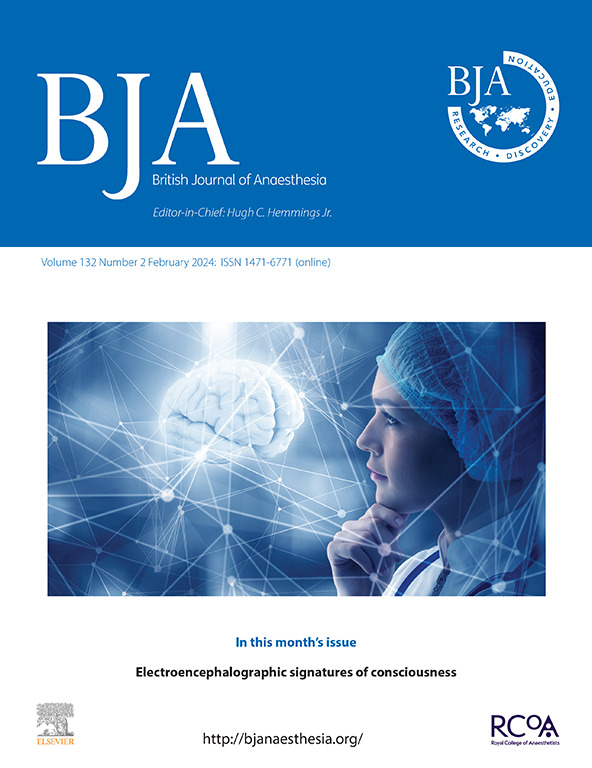术前自由清液禁食方案对儿童肺误吸风险的影响(EUROFAST):一项国际前瞻性队列研究。
IF 9.1
1区 医学
Q1 ANESTHESIOLOGY
引用次数: 0
摘要
背景:术前禁食方案旨在将肺吸入风险降至最低,这一方案已经发生了重大变化,但缺乏明确的证据证明减少透明液体禁食的安全性。我们比较了使用三种不同的清液禁食建议的儿童肺误吸的风险。方法在这项前瞻性多中心队列研究中,每年有1000例儿科麻醉病例的中心符合条件。返流事件,无论是短暂的还是导致影响术后护理的后果,都被详细报道。所有中心还报告了每年麻醉儿童的数量以及他们使用的术前禁食方案。结果31家中心共实施30900例麻醉手术。≥1 h组确诊肺误吸发生率为1.18:10 000,≥1 h组为0.96:10 000,对照组为1.83:10 000。没有因误吸而死亡。对照组与≥1 h清液禁食组和sip- il-send组确诊肺误吸差异的95%置信区间分别为-0.344 ~ 3.76和-1.48 ~ 3.63。在确认误吸、一过性反流和反流导致护理升级或重症监护的发生率方面,啜吸-送和≥1小时清液禁食在统计学上都不低于≥2小时清液禁食。结论本研究为将<16岁儿童术前清液禁食时间从2小时缩短至≤1小时的安全性提供了证据。本文章由计算机程序翻译,如有差异,请以英文原文为准。
Impact of liberal preoperative clear fluid fasting regimens on the risk of pulmonary aspiration in children (EUROFAST): an international prospective cohort study.
BACKGROUND
Preoperative fasting regimens designed to minimise the risk of pulmonary aspiration have undergone significant changes, but unequivocal evidence of the safety of reducing clear fluid fasting has been lacking. We compared the risk of pulmonary aspiration in children using three different recommendations for clear fluid fasting.
METHODS
In this prospective multicentre cohort study, centres with >1000 paediatric anaesthesia cases per year were eligible. Regurgitation events, whether they were transient or led to consequences affecting postoperative care, were reported in detail. All centres also reported the number of anaesthetised children per year and which preoperative fasting regimen they used.
RESULTS
The 31 participating centres contributed a total of 306 900 anaesthetic procedures. The incidence of confirmed pulmonary aspiration was 1.18:10 000 in the sip-til-send group, 0.96:10 000 in the ≥1 h group, and 1.83:10 000 in the control group. There was no mortality as a result of aspiration. The 95% confidence intervals of the differences in confirmed pulmonary aspiration between the control group and the ≥1 h clear fluid fasting and the sip-til-send group were -0.344 to 3.76 and -1.48 to 3.63, respectively. Both sip-til-send and ≥1 h clear fluid fasting were statistically noninferior to ≥2 h clear fluid fasting regarding the incidence of confirmed aspiration, transient regurgitation, and regurgitation leading to escalation of care or intensive care.
CONCLUSIONS
The study provides evidence for the safety of reducing preoperative fasting time for clear fluids in children aged <16 yr from 2 h to ≤1 h.
求助全文
通过发布文献求助,成功后即可免费获取论文全文。
去求助
来源期刊
CiteScore
13.50
自引率
7.10%
发文量
488
审稿时长
27 days
期刊介绍:
The British Journal of Anaesthesia (BJA) is a prestigious publication that covers a wide range of topics in anaesthesia, critical care medicine, pain medicine, and perioperative medicine. It aims to disseminate high-impact original research, spanning fundamental, translational, and clinical sciences, as well as clinical practice, technology, education, and training. Additionally, the journal features review articles, notable case reports, correspondence, and special articles that appeal to a broader audience.
The BJA is proudly associated with The Royal College of Anaesthetists, The College of Anaesthesiologists of Ireland, and The Hong Kong College of Anaesthesiologists. This partnership provides members of these esteemed institutions with access to not only the BJA but also its sister publication, BJA Education. It is essential to note that both journals maintain their editorial independence.
Overall, the BJA offers a diverse and comprehensive platform for anaesthetists, critical care physicians, pain specialists, and perioperative medicine practitioners to contribute and stay updated with the latest advancements in their respective fields.

 求助内容:
求助内容: 应助结果提醒方式:
应助结果提醒方式:


